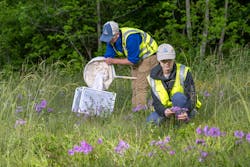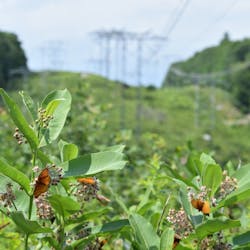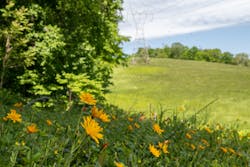National Grid’s Biodiversity Study for Integrated Vegetation Management
With a system of rights of way (ROWs) extending throughout New England and New York, National Grid manages an expansive network of electricity and natural gas distribution to more than 20 million people. Just as it’s essential to maintain those services to its customers and partners, it’s essential for the utility to be a proactive leader in environmental stewardship — the caretaking of the land it manages and all that lives and relies on it.
National Grid is no stranger to this effort. With educational and professional backgrounds in environmental studies, the vegetation management team members are responsible stewards of the land on which they’ve worked. Every day, the team prioritizes efforts not only in maintaining land but also in making proactive decisions that will benefit future generations within the organization and the community.
Launching Pilot Programs
A key initiative for the vegetation management team has been implementing new, creative solutions under the Responsible Business Charter. For example, the team is striving to improve the environmental value of 10% of the land under the team’s care by 2030.
To that end, the team has launched pilot programs focusing on promoting biodiversity and pollinator habitats. One of these was the installation of two honeybee hives near National Grid’s Northboro, Massachusetts, facility. The hives, which are now home to more than 20,000 honeybees, will contribute to pollinator research while bolstering the local pollinator population.
The second pilot program focuses on off-road greenspaces found under power lines in the ROWs. Historically, the only way to maintain these ROWs has been through a combination of mowing on periodic cycles as well as the use of integrated vegetation management (IVM) solutions, such as the application of herbicides that target incompatible and invasive plant species. National Grid has been using IVM on its ROWs since the late 1950s. However, a few challenges arose from this approach over the years:
- Mowing reduces the available coverage for pollinating insects and reduces seedstock for pollinating plants in soil, reducing their populations over winter. Mowing ROWs is also a significant, ongoing investment for the organization.
- Multiple IVM techniques have historically been used on ROWs, at times leading to pushback from landowners. Nationally, herbicides are also often the focus of legislation intended to ban their use, causing a negative perception.
- There was a distinct need to build greater interest in IVM, the importance of the program, and the impact it makes on the environment and to increase involvement and awareness in IVM vendors.
Addressing These Challenges with a Biodiversity Study
In early 2021, National Grid made the strategic decision to undertake a biodiversity study of several areas on its system. To bring this initiative to life, the utility turned to its industry vegetation management partner, ACRT Services, and its Research, Science & Innovation (RSI) team. Led by Dr. Anand Persad, the RSI team is committed to advancing the scientific process as it pertains to environmental analysis for the energy industry, focusing on the integration of artificial intelligence and data-driven greenspace protocols, and building on sustainable ideals and metrics. Its biodiversity study, called BIOaudit, is a comprehensive environmental assessment that is evaluated seasonally.
National Grid examined plots across Massachusetts, New Hampshire, Rhode Island and Vermont that are currently managed using IVM techniques. In some instances, they have reduced mowing, which allows native pollinator populations to increase while reducing the associated costs.
The utility’s vegetation management team can align the data-backed nature of the BIOaudit study, which measures the effectiveness of the IVM program, to the utility’s programs and their cycles. This is important as it pertains to preserving the compatible low-growing plant communities, which are able to thrive between treatments that typically occur every four to five years. The team members can now be more effective as their future work planning will be based on efficacy data that is current. They can also better inform and educate adjacent landowners so they understand the effectiveness of the utility’s IVM program. Over time, the data will also be used to address the third challenge mentioned above.
National Grid plans to continue the study over multiple years to accurately measure progress. In the study, the utility’s industry partners at ACRT Services measured native seed banks, beneficial plants and insect communities along 222 standardized plots — using established scientific sampling methods for understanding abundance as well as presence — at 15 different areas across the system, which includes several eco-sensitive areas.
Early on, the study has provided a comprehensive list of native plant populations, some of which the team was not aware were in local abundance, which was a good sign. The ecological progression measured across these sites has been strong as well, demonstrating — scientifically — the value of IVM, thereby validating the team’s approach and enabling it to justify its efforts with landowners, communities and the industry as a whole. The study has also opened doors to
new landowners who are interested in trying herbicide as a means for addressing invasive plant species.
Knowledge Paves a Way Forward
Long-term, the results of the BIOaudit study are expected to enable a reduction in the usage of herbicide along ROWs; use more and better technology when planning and implementing herbicide applications; increase sustainable ground cover across our ROWs; increase the variety and timing of blooms that provide nectar and pollen; increase food, shelter and protection for insects and other wildlife; and decrease the amount and frequency of input needed on ROWs, thereby reducing our overall carbon footprint from soil to sky.
As data is collected in future seasons, the team plans to continue to communicate and share information and resources about the program within the organization and to the communities it serves. Industry colleagues have also taken note of the program and have reached out.
Additional communications are planned to further these educational efforts. The team members also implemented more public-facing communications, such as a website detailing the program and relationship with the ACRT Services RSI team.
As National Grid continues to invest in this program and seek additional ways to strengthen its environmental stewardship, the utility is encouraging colleagues and associates to ask what they can be doing to better understand and learn from their land. The ROWs the vegetation management team manages and the plants, insects, avian population and wildlife they support are critical. Land managers have an amazing opportunity to learn from what’s happening — or not happening — on them.
Mariclaire Rigby ([email protected]) is the lead vegetation strategy specialist for National Grid, where she previously served as the senior transmission forester. Prior to joining National Grid, Rigby worked as a utility transmission forester for Davey Resource Group. She has also held roles as an arborist and urban forester with regional forest services including the U.S. Forest Service. She earned her bachelor’s degree in natural resource management from the State University of New York College of Environmental Science and Forestry.
About the Author
Mariclaire Rigby
Mariclaire Rigby is the lead vegetation strategy specialist for National Grid, where she previously served as the senior transmission forester. Prior to joining National Grid, Rigby worked as a utility transmission forester for Davey Resource Group. She has also held roles as an arborist and urban forester with regional forest services including the U.S. Forest Service. She earned her bachelor’s degree in natural resource management from the State University of New York College of Environmental Science and Forestry.



